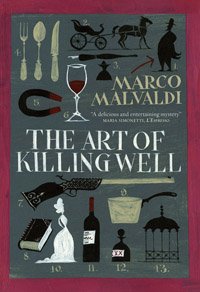Translated by Howard Curtis — Having recently reviewed Game for Five, which was published in April, we move quickly on to the author’s latest translated release. A country house murder mystery, complete with locked room conundrum and a nod to the Golden Age, The Art of Killing Well is set in a Tuscan castle in the year 1895. It’s the home of the seventh Barone di Roccapendente and his extended family, all of whom seem indolent, rude or quite simply barking mad.
On this particular weekend they plan to hunt wild boar. The Barone has invited not only the reputable photographer Signor Ciceri, but also the real life chef Pellegrino Artusi who is compiling his masterpiece, The Science of Cooking and The Art of Eating Well.
With two cats as companions, and his well-thumbed edition of Sherlock Holmes, Artusi’s presence is an absolute joy, giving rise to the inveterate snobbery of the Barone’s clan, however he is generally indifferent to the supposed wealth and influence of his hosts. Things get underway with a murder. This time, it wasn’t the butler… no, he was the victim. Artusi, with his nose for a mystery, relishes the challenge of unmasking a killer. As he delves into the inner workings of this not so noble family, he uncovers a hotbed of gambling, sexual shenanigans and greed, but can he reveal the true murderer?
Few books make me laugh out loud, but the acidic and wry humour here is pure entertainment. With the gentle intrusion of an omniscient narrator, who provides a series of observations from a contemporary viewpoint as well as injecting dry asides as to the moral integrity of the aristocratic family, the book sparkles with wit. Malvaldi excels in a series of humorous little vignettes, detailing the weaknesses and foibles of these eccentric and incredibly dislikable people. Characters are described variously as having the intelligence of a fruit bowl, or dressing in a cross between a monk’s habit and a grain silo. Much fun is poked at the idiosyncrasies of the rich along with cynical asides about the politics and social mores of the period. The natural alacrity and joie de vivre of Artusi is set against the rather buttoned down dryness of his eminent hosts. The author garners considerable enjoyment from the jokes at their expense.
The rumbustious Artusi is a wonderfully warm and multi-layered character, seemingly intent on just sampling the earthy and rustic Tuscan fare for his cookery book, but actually donning the mantle of detective with consummate ease, walking in the footsteps of his hero Holmes. Added to the mix is local policeman l’inspettore Artistico, who has little time or patience for the demands of the Roccapendente family, but who forms a touching alliance with our chef in the course of the investigation, particularly in the wake of a second attempted murder.
It is not a thick book, but a fully satisfying one not only due to how the unfortunate butler is dispatched, but also because of how this death unearths such a viper’s nest of corruption. The plot unfolds with all the charisma of a traditional Agatha Christie, but its near-the-knuckle humour and bizarre characters provide an all together more fulfilling reading experience. A perfectly bijou and mischievous crime book, I would be more than happy to read it again in years to come.
Maclehose Press
Print/Kindle/iBook
£5.66
CFL Rating 5 Stars









